List of World Heritage Sites in Armenia facts for kids
The United Nations Educational, Scientific and Cultural Organization (UNESCO) helps protect important places around the world. These places are called World Heritage Sites. They are special because they have amazing cultural or natural value for everyone.
Cultural sites include old buildings, statues, or archaeological areas. Natural sites are places with unique plants, animals, or beautiful landscapes. Countries that agree to the UNESCO World Heritage Convention, started in 1972, can suggest sites. Armenia joined this agreement on September 5, 1993.
Armenia has three sites on the World Heritage list. All of them are monasteries, churches, or other religious places. The first site listed was the Haghpat Monastery in 1996. In 2000, the Sanahin Monastery was added to this site. Also in 2000, two more sites were added: the Cathedral and Churches of Echmiatsin with the old site of Zvartnots, and the Monastery of Geghard along with the Upper Azat Valley. All three of Armenia's sites are cultural. Armenia also has four more sites that might be added to the list in the future.
Armenia's World Heritage Sites
UNESCO lists sites based on ten different rules or "criteria." Each site must meet at least one of these rules. Rules one to six are for cultural sites, and rules seven to ten are for natural sites.
| Site Name | Picture | Location | Year Added | UNESCO Info | What Makes it Special |
|---|---|---|---|---|---|
| Monasteries of Haghpat and Sanahin | 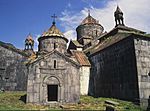 |
Lori Province | 1996 | 777bis; ii, iv (cultural) | The monasteries of Haghpat and Sanahin were built in the late 900s. Queen Khosrovanush, wife of King Ashot III, helped pay for them. More buildings were added until the 1200s. These monasteries mix styles from Byzantine churches with local building traditions from the Caucasus region. Haghpat Monastery (shown here) was listed in 1996, and Sanahin Monastery was added in 2000. |
| Monastery of Geghard and the Upper Azat Valley | 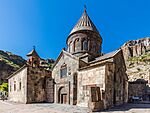 |
Kotayk Province | 2000 | 960; ii (cultural) | The Geghard Monastery is in the Azat River gorge. People believe Saint Gregory the Illuminator started the monastery in the 300s. This was when Christianity became the main religion in Armenia. The main buildings you see today are from the 1200s. They include churches carved into rock, tombs, living spaces for monks, and several khachkars (Armenian stone crosses). This monastery was a very important religious and cultural center in medieval Armenia. |
| Cathedral and Churches of Echmiatsin and the Archaeological Site of Zvartnots | 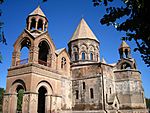 |
Armavir Province | 2000 | 1011; ii, iii (cultural) | This site includes churches that show how Armenian church architecture changed over time. The churches in Echmiadzin (now called Vagharshapat) include the Etchmiadzin Cathedral (started in 301, pictured). There's also Saint Gayane Church (from 630), Saint Hripsime Church (from 618), and Shoghakat Church (built in 1694 on an older chapel). The Zvartnots Church was built in the 600s but was destroyed around the 900s, possibly by an earthquake. |
Possible Future World Heritage Sites
Besides the sites already on the World Heritage list, countries can also keep a "tentative list" of places they might suggest later. A site must be on this tentative list before it can be officially nominated. Armenia has four such sites.
| Site Name | Picture | Location | Year Added | UNESCO Rules | What Makes it Special |
|---|---|---|---|---|---|
| The Ancient City of Dvin | 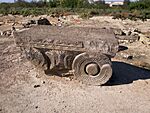 |
Ararat Province | 1995 | ii, iii, vi (cultural) | King Khosrov III built a palace in Dvin in the 300s. It became the capital of Armenia and the main seat for the head of the Armenian Church. Dvin was an important regional capital during the Sasanian period and under the Caliphate. It was destroyed by the Mongols in the 1200s. |
| The Basilica and Ancient Site of Yererouk | 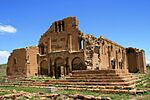 |
Shirak Province | 1995 | iii, iv, vi (cultural) | This old church was built in the 300s CE. It is one of the earliest Christian buildings in Armenia. An earthquake in the 1600s damaged it, and now it is in ruins. |
| The Monastery of Noravank and the Upper Amaghou Valley | 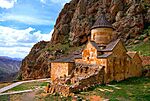 |
Vayots Dzor Province | 1995 | i, iii, vi, vii, ix (mixed) | This monastery is from the 1200s and is located in a river gorge. Some of its buildings were designed by a famous architect named Momik. |
| The Monasteries of Tatev and Tatevi Anapat and the Vorotan Valley |  |
Syunik Province | 1995 | i, ii, iv, vi, vii, ix (mixed) | The Tatev monastery, built between the 800s and 1200s, sits high above the Vorotan gorge. The Tatevi Anapat monastery, from the 1600s, is at the bottom of the valley. The gorge itself is very deep, about 850 meters (2,790 feet), making it the deepest in Armenia. |
| Vishaps and the Cultural Landscape of Tirinkatar | 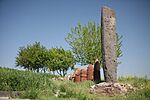 |
Aragatsotn Province | 2024 | ii, iii, vi (cultural) | In the high mountains of Armenia, you can find unique ancient stone monuments called "vishap" by local people. This word means "dragon" in Armenian. These are tall basalt stones, two to five meters high. They are special because of their unique animal carvings and where they are placed. Some vishaps look like fish, others look like animal hides draped over them, and some combine both styles. |
See Also
 In Spanish: Anexo:Patrimonio de la Humanidad en Armenia para niños
In Spanish: Anexo:Patrimonio de la Humanidad en Armenia para niños
- List of Intangible Cultural Heritage in Armenia
- Tourism in Armenia

